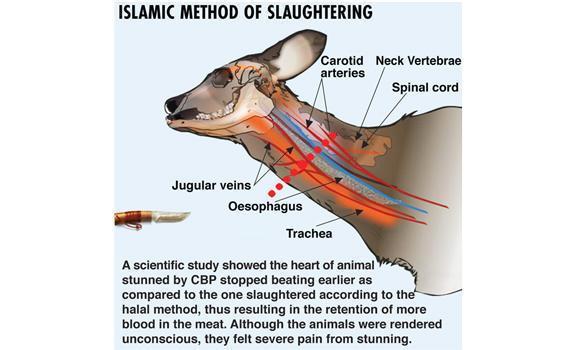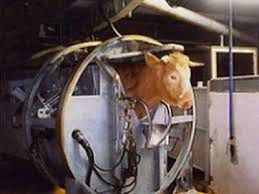( فَكُلُوا مِمَّا ذُكِرَ اسْمُ اللَّهِ عَلَيْهِ إِن كُنتُم بِآيَاتِهِ مُؤْمِنِينَ )
(So eat of that [meat] upon which the name of Allah has been mentioned, if you are believers in His verses) (6 -118) the Cattle – al-An’Am – الأنعام
( In the name of Allah, Allah is the Greatest )

Dhabīḥah (or zabiha, Arabic: ذَبِيْحَة ) is, in Islamic law, the prescribed method of ritual slaughter of all lawful halal animals (goats, sheep, cows, chicken) excluding locusts, fish, and most sea-life. Unlawful animals like pigs, dog, kangaroo, boar, etc. are not allowed to be slaughtered or zabihah. This method of slaughtering lawful animals has several conditions to be fulfilled. The butcher must be Muslim, the name of God or “In the name of God” (Bismillah) must be called by the butcher upon slaughter of each halal animal separately, and it should consist of a swift, deep incision with a very sharp knife on the throat, cutting the wind pipe, jugular veins and carotid arteries of both sides but leaving the spinal cord intact.
According to the Islamic law, halal ritual slaughter is an act of adoration. It is performed manually.
It is to be performed for Allah (Subhanahu wa Ta’ala), the One and Only God, only for Him and in a manner that He approved and allowed, and with the intention of ensuring proper nutrition.
Offertory is the worship of the One and Only God, therefore it cannot be replaced by a machine with a sharp mechanical knife. Ritual slaughter must be performed properly. In order to kill small animals (sheep, poultry and cattle), the neck should be cut below the larynx: pharynx, oesophagus and large blood vessels, with one move. The larynx must stay close to the head.
Ritual slaughter is perfect if it meets the following conditions:
1. Ritual slaughterer:
– A ritual slaughterer should be a practising Muslim, a mature and sensible man, competent in the area of ritual slaughter.
– A ritual slaughterer must pray five (5) times a day, in a timely manner.
– Mature: an immature person should not perform ritual slaughter.
– Sensible: killing an animal by a madman, drunkard, drug addict, child (immature) or a mentally ill person is against the law.
– Specialist: he must be approved and authorized to perform ritual slaughter.
– A ritual slaughterer must demonstrate perfect hygiene and wear appropriate clothing. He should be dressed in accordance with health protection regulations.
2. Ritual slaughter tools and devices:
– An animal must be trapped in an appropriate trap device.
– A box or a cage must be easy to use and open without noise to prevent stress of the animal.
– In order to avoid stress, pain and wing fracture, birds can also be trapped in an appropriate device. Poultry can be hanged by the legs on a slaughter line.
– Knives used for slaughter must be sharp, have rigid blades and be resistant to corrosion, so as to ensure quick and immediate death of an animal. They cannot be used for any other purposes than ritual slaughter.
– Knives must be sharpened before every slaughter to prevent pain.
– The room where slaughter takes place must be equipped with a sufficient number of knives and sharpening machines.
3. Animals
– All animals intended for slaughter must undergo examination (ante mortem) performed by veterinary services.
– Ill animals, in the state of clinical death, bitten by a wild animal, afflicted by diseases contagious for people (zoonosis) and with high temperature are not killed, because they are not halal, i.e. not healthy.
– Tired and stressed animals after the transport must rest before the slaughter.
– In order to avoid visual stress in animals before ritual slaughter, one should avoid situations in which animals could see a knife or a death of other animals.
– Land animals, accepted for consumption, killed by: suffocation, stunning by hitting in the head, electric shock, immersion in hot water or gassing that is not allowed (Arab. haram) are not accepted for consumption.
– Brutal treatment of these animals is unacceptable. Proper treatment of animals is the chief rule.
4. Humane conditions during ritual slaughter of cattle:
Cattle slaughterhouses in Poland are equipped with a holding system used to immobilize an animal before ritual slaughter.
a) Hygiene before ritual slaughter
Ritual slaughterers must take care of personal hygiene and wear appropriate clothing that meets sanitary regulations. Food hygiene in Islam is based on the fact that animals bleed quickly, without stunning and stress, and the meat remains clean. Blood is a habitat of diseases and a threat to human health.
b) The conditions of animal slaughter legal validity according to the Islamic law:
An animal must be kept in a trap appropriate for a given species. It is recommended that a ritual slaughterer directs an animal towards quibla (the direction of Mecca). A ritual slaughterer must be in the state of cleanliness (tahir: ghusl). He should preferably perform ablution (wudhu). A ritual slaughterer, in order to express his intention to sacrifice, must pronounce the name of God and say: “Bismillah, Allah Akbar” (In the name of Allah, Allah is the Greatest). If this is forgotten unintentionally – it does not have any consequences. If this is omitted intentionally – the meat is not accepted for consumption (it is treated as non-halal).
Killing animals in Islam is a method of ritual slaughter of edible land animals, practised by means of a deep and quick incision of throat with a sharp knife, in order to cut the carotid quickly and to leave the spinal cord. The purpose of this technique is to easily remove blood from an animal’s body in a way to leave the meat clean.
Animals are killed with one or two moves with a sharp knife (there and back). A tool used for slaughter must be sharp to prevent additional pain and long suffering. The cut should not be made in the presence of another animal, as the sight of slaughter evokes unnecessary stress and anxiety. A knife should not be sharpened in front of an animal.
Animals are killed through the simultaneous cut of the trachea under the larynx and on both sides of carotid arteries and jugular veins. One should wait several minutes after the slaughter to allow the leakage of blood from the cut carotid. The animal stays in the trap until it loses blood to death. After it stops fighting, it falls on the floor and is immediately hanged to lose all the blood. The suffering experienced by an animal is limited to the knife going through the skin. Contractions of limbs after slaughter and bleeding do not signify pain. It is a natural nervous reflex due to the lack of blood supply and brain oxygenation. These contractions help to expel the maximum amount of blood from the body.
It is not allowed to make any cuts on an animal (e.g. cutting legs or head) before its complete death (the last gleam of the retina is the sign of death).
If carotid arteries are blocked (a physiological reaction of the narrowing of vessels), the ritual slaughterer makes an incision in the neck tip in order to release blood. One cannot start the process of cutting up or break the spine before the complete descent of its soul.
c) Hygiene after ritual slaughter
Once the skin is removed, gutting should be made immediately and quickly in order to prevent intestinal bacteria from penetrating into deep tissues. Meat in containers should not have a direct contact with the ground. Staff responsible for supervision and sanitary inspection is obliged to carry out regular general hygiene inspections and microbiological inspections of halal products and used devices, i.e. the “contact points”. The facility must inform about the planned inspection, its nature, frequency and the results of microbiological controls.
Summary of conditions for halal slaughter
Islamic law requires that animals intended for human consumption be slain in a certain manner.
The conditions for halal slaughter can be summarized as follows:
– The animal to be slaughtered must be from the categories that are permitted for Muslims to eat.
– The animal must be alive at the time of slaughter.
– No electric shock, bullet or any other means should be used before slaughtering. Using any such method may lead to the death of the animal before it is cut. Islam prohibits Muslims from eating any meat coming from an animal that is dead before slaughter. Muslims are also advised to avoid eating anything doubtful.
– The animal must be slaughtered by the use of a sharp knife. The knife must not kill due to its weight. If it kills due to the impact the meat may not be permissible.
– The windpipe (throat), food-tract (oesophagus) and the two jugular veins must be cut.
– The slaughtering must be done in one stroke without lifting the knife. The knife should not be placed and lifted when slaughtering the animal.
– Slaughtering must be done by a sane adult Muslim. Animals slaughtered by a Non Muslim will not be halal.
– The name of Allah must be invoked (mentioned) at the time of slaughtering by saying: “Bismillah Allahu Akbar”. (In the Name of Allah; Allah is the Greatest.)
– If at the time of slaughtering the name of anyone else other than Allah is invoked (i.e. animal sacrificed for him/her), then the meat becomes haram “unlawful.”
– If a Muslim forgets to invoke the name of Allah at the time of slaughtering, the meat will remain halal. However, if he intentionally does not invoke the name of Allah, the meat becomes haram.
– The head of the animal must not be cut off during slaughtering but later after the animal is completely dead, even the knife should not go deep into the spinal cord.
– Skinning or cutting any part of the animal is not allowed before the animal is completely dead.
– Slaughtering must be made in the neck from the front (chest) to the back.
– The slaughtering must be done manually not by a machine, as one of the conditions is the intention, which is not found in a machine.
– The slaughtering should not be done on a production line where pigs are slaughtered. Any instrument used for slaughtering pigs should not be used in the halal slaughtering.
Customary and desirable practices when slaughtering
– Water should be offered to the animal before slaughter, and it should not be slaughtered when hungry.
– The knife should be hidden from the animal, and slaughtering should be done out of sight of other animals waiting to be slaughtered.
– Animals should be killed in a comfortable way. Unnecessary suffering to them must be avoided.
– The knife should be re-sharpened before slaughter.
Storage, processing and transport of halal meat
– Meat chilled or frozen for export to Muslims should be stored in separate cold stores other than those in which pork or other non-halal meat is stored.
– Meat minced or processed for Muslims should not be minced in the same machines used to mince pork or other non-halal meat.





